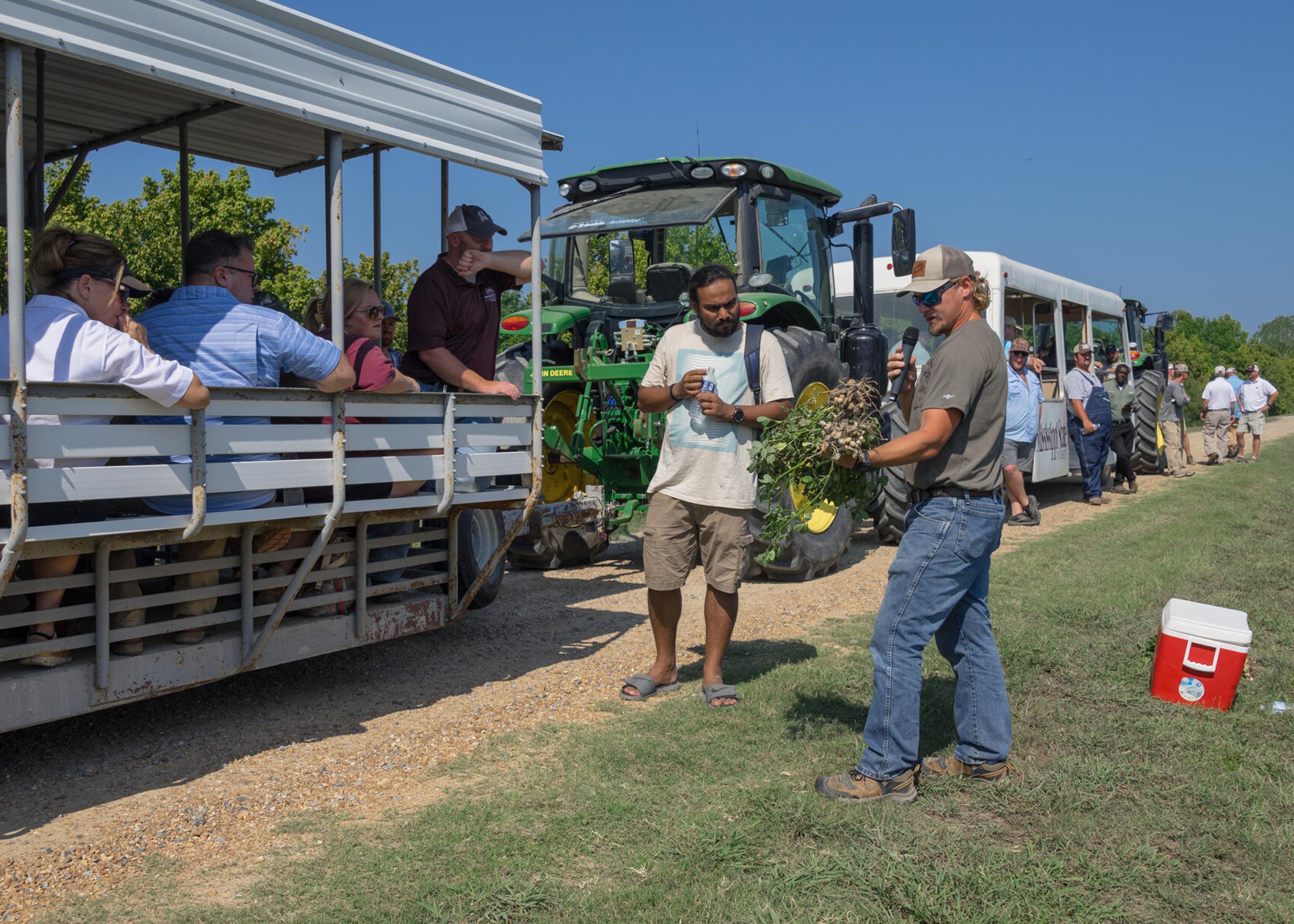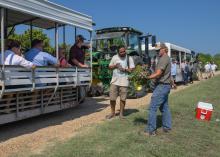Field day spotlights MSU row crop research
STARKVILLE, Miss. -- Producers got a behind-the-scenes look at the wide scope of agricultural research taking place at Mississippi State University in an Aug. 6 event.
Faculty and specialists with the MSU Extension Service and the Mississippi Agricultural and Forestry Experiment Station presented on-farm research projects designed to help growers meet the challenges of row crop production.
Producers toured the MAFES R. R. Foil Plant Science Research Center, also known as North Farm, and learned about ongoing research ranging from microbial studies in cotton and peanut disease management to insecticide seed treatments and aerial herbicide applications.
MSU Extension entomologist Whitney Crow leads the MSU row crop entomology research programs both at North Farm and on farms in the Mississippi Delta. She provided updates on insect pressure studies taking place at each location.
“We try to replicate everything we do here, also in the Delta, just because pest pressure tends to be different,” she explained to growers. “We have various graduate student projects focusing on how we can potentially minimize our input costs as market values change for certain commodities. And we have a graduate student who will be re-evaluating insecticide seed treatments at various planting dates to see if there are times when we can get away with just using a fungicide-only seed treatment.
“A lot of our resources and energy are going into tarnished plant bugs,” Crow added. “That’s our most economically damaging pest, so we’re looking at how we can continue to use new and emerging technologies with current management.”
MSU Extension peanut specialist Brendan Zurweller showed growers the effects of various soil and foliar diseases such as Southern blight and leaf spot on peanut plants. Because this commodity is highly susceptible to disease, a large portion of peanut research at MSU focuses on disease management.
“There have been some new peanut cultivars released that have improved tolerance to late leaf spot, but we need some more data on their tolerance to early leaf spot,” he said. “We’re poised here to look at it, because in this region, we have predominantly all early leaf spot. The first thing we’re testing is the tolerance: Do the cultivars have high tolerance to early leaf spot the same as late leaf spot, since they’re two different pathogens?
“The second question that we’re looking at is if we have improved tolerance to leaf spot, is that going to change management, and particularly fungicide management?” Zurweller added. “What we’re hoping is that with this improved tolerance, we can reduce the number of fungicide sprays, or at least the cost of the fungicide inputs.”
The tour also featured a demonstration of a remotely piloted aerial application system, or a spray drone, led by Madison Dixon, associate director of research for the MSU Agricultural Autonomy Institute. The drone, manufactured by Leading Edge Aerial Technologies, was flown over one of the soybean variety trial fields to show how it could apply herbicides to plants overhead.
“I can’t stress enough how well-suited Mississippi State is to do this work, and not only to do the research but to ensure the research ultimately leads to actionable, real-world benefits for our growers,” Dixon told attendees. “We’re able to do that through the Mississippi Agricultural and Forestry Experiment Station. We’re also able to do that through MSU Extension.
“Everything we do has an eye towards the grower and making sure the grower is able to get real-world benefits out of the work being done here every day,” he added. “The spray drones are just one of the latest and most exciting examples of that.”
Crow said public events like the field day are one of many avenues for MSU Extension and MAFES to share their research efforts with growers and hear their thoughts on research that should be pursued in the future.
“The things we’re doing in all of these various programs are to help Mississippi producers and Mississippi agriculture,” she said. “Their support and the dollars that are going into these programs are being utilized to best answer some of these questions that we’re facing, especially as we move forward in agriculture with various regulations and cost input increases. We’re doing the best on our end to help be good stewards of the resources we have and help provide solutions to the issues Mississippi producers face.”









